How To Defend In A 3-5-2 Formation
Defending in a 3-5-2 is a formation that can allow you to press high with two forwards without being overloaded in midfield and whilst keeping a solid structure on your backline.
The system can also be easily adapted to create a back five when teams are defending their box.
This tactical analysis will examine the formation’s benefits and drawbacks in the defensive phase.
Using examples from the 2022 FIFA World Cup, this tactical theory will analyse the 3-5-2 tactics deployed by Louis van Gaal‘s Netherlands.
This analysis includes guidance on how coaches can implement these defending tactics.
Forwards pressing

The above image shows the Netherlands’ front two of Liverpool‘s Cody Gakpo and Ajax‘s Steven Bergwijn pressing against Ecuador.
One forward applied pressure to the ball whilst arching their run and running at the goalkeeper’s outside foot.
This movement forces the opposition’s receiving player to open up and play out the other side.
With the ball-far forward protecting the middle with his starting position, the goalkeeper has only one risk-free pass to the right of his box
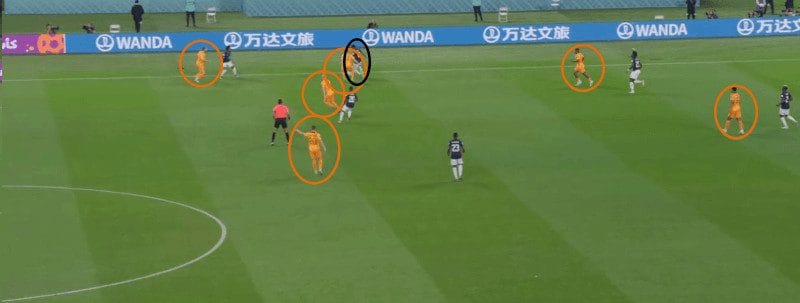
Because the forwards made the opposition’s play predictable, the Netherlands could overload that side of the pitch.
The ball-near wing-back (furthest left on the image) tracked his man into the opposition’s half.
The ball-far wing-back (out of shot) tucked in beside his centre-backs to create a temporary back four.
Defending the box
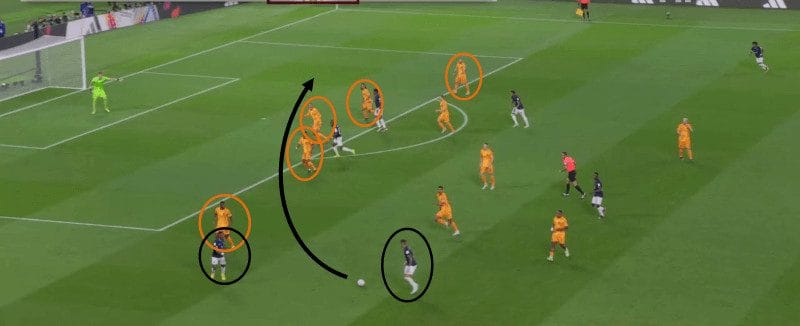
A great benefit of the 3-5-2 system is that it allows teams to defend their box with five players.
As the above example shows, if one of the five defends the wide area, with the ball far-wing-back tucked in, there is still four defenders to cover the box.
One difficulty this formation can create, as in this situation, is applying pressure to the ball when the opposition doubles up in the wide area.
Here, the wing-back is pinned by the wide-forward, allowing the opposition’s full-back to receive alone from a switch of play.
Whilst the midfield shifts quickly, they can only apply half-pressure when the cross is delivered.
Although they are unable to prevent the cross, the Netherlands have enough bodies across the edge of the box to defend it comfortably.
Defensive overload
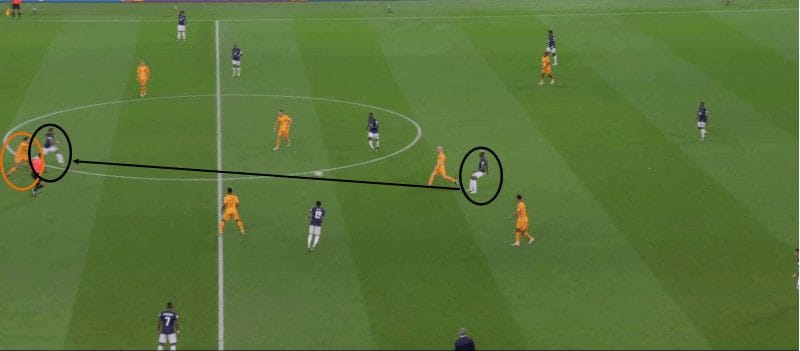
Another benefit of having a back three, this time higher up the pitch, is that (usually) provides a defensive overload.
This allows centre-backs to track movements by forwards into midfield tightly.
This removes the need to pass players on to midfielders and any ambiguity that can occur in these situations.
The above example shows Ecuador opening up a passing lane for their striker, who is being marked by former Celtic player Virgil van Dijk.
Instead of passing the forward on, the Champions League winner tracks him into an area usually reserved for central midfielders.
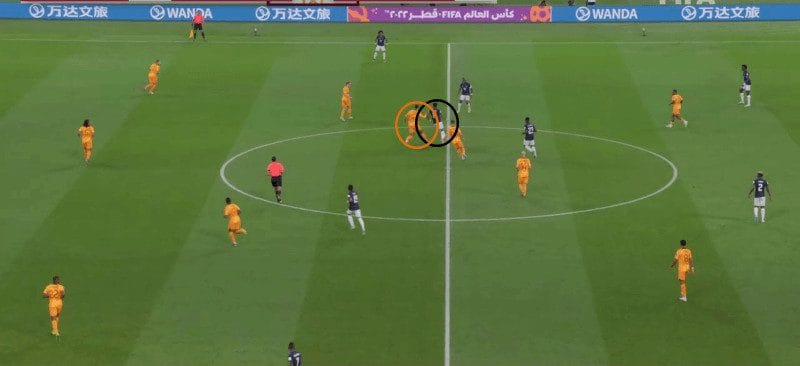
With no other forward playing up against them, the covering defenders can comfortably cover the space Van Dijk has vacated.
Without having to worry about what’s behind him, the defender stays tight to his man, beyond his midfielders, preventing his mark from turning with the ball.
Coaching defending in a 3-5-2
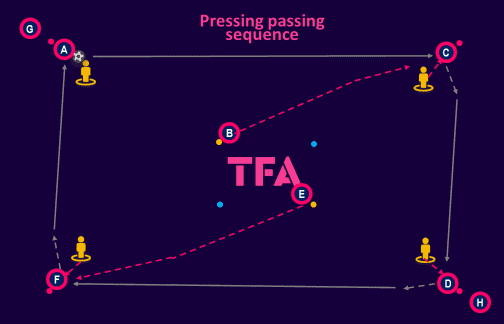
This training session is designed to touch on several aspects of defending in a 3-5-2, with each line of defence being given focus.
Depending on how much contact time they have with their players, coaches may choose to work on each phase in separate training sessions.
The session begins with a passing exercise that could be incorporated as part of the warm-up.
This exercise is designed to allow the forward players to practice pressing to keep the opposition playing down one side.
The sequence begins with player “A” passing to player “C” and the ball (or balls) continuously moving around the outside of the square.
Players “B” and “E” are the “pressing” players.
After playing the first pass, “A” moves to position “B”, “B” to “C”, and so forth.
As the ball is travelling on the outside of the long side, the middle players, shown as “B” and “E”, “press” the receiving player.
The pressing players should begin their movement as soon as the ball is played across the long side of the box.
They should be encouraged to slightly loop their runs and sprint at the receiving players’ inside foot.
This replicates one striker initiating the press whilst attempting to keep a team going down one side of the pitch.
At the beginning of the exercise, the pressing players are not allowed to steal the ball.
However, the passing players should be encouraged to play quickly so as not to be caught by the defending player.
This should also keep the exercise moving at match intensity.
To progress the exercise, the players receiving under pressure can be made to dribble with the ball halfway between the mannequins before playing the pass.
The pressing players can then take the ball from them, with the coach keeping count of who creates the most turnovers.
Two sets of coloured cones are set up in the middle of the square to allow the exercise to change direction efficiently.
Front two rondo
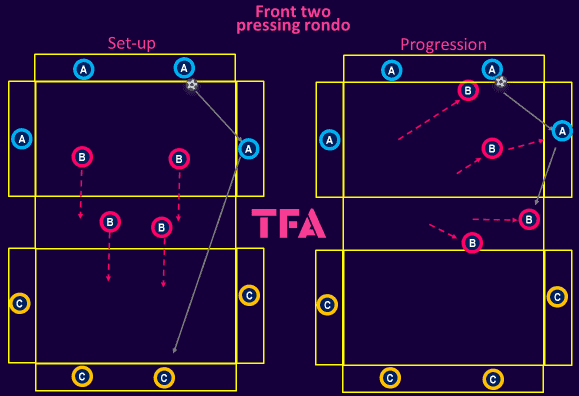
As with the passing exercise, this rondo is designed to work on the front two’s pressing, aiming to trap a team down one side of the pitch.
The rondo consists of three teams of four.
Two teams keep possession, whilst one team of four presses.
The aim is for the in-possession teams to connect a pre-determined number of passes before transferring the ball to the opposite box.
The in-possession players, shown as blue and yellow above, must stay in their assigned zones to replicate the set-up of a back four.
Initially, the defending team (pink) presses in pairs, with one pair resting in between the two boxes.
When the ball is transferred to the opposite box, the resting pair become the pressers.
Should the pressing team intercept the ball, they should transition by playing a pass into the opposite box.
The team that just lost possession then becomes the pressing team.
The rondo can be progressed to having the pair between the boxes become active and able to intercept the ball.
The two pressing players, representing the forwards, should be coached in movements that make the in-possession teams’ next pass predictable.
As shown on the right of the diagram, this allows the midfielders to shift behind them to overload one side of the area.
This closes down passing lanes, trapping teams on one side.
Small-Sided – Mid-Block Game
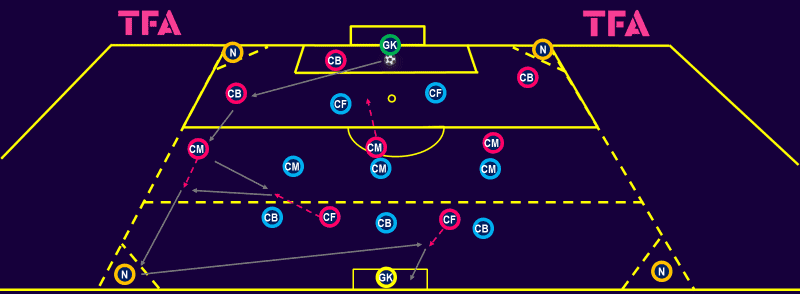
This small-sided, eight Vs eight zone game is designed to work on how to defend in a 3-5-2 and can replicate either a high press or mid-block.
Specifically, it aims to develop the central midfielders’ reaction when the first line of pressure is broken and they are exposed.
Both teams are set up similarly, with three centre-backs, three central midfielders and two forwards.
To begin the play, the centre-backs must receive the ball from the goalkeeper and progress the ball into the middle zone while pressed by the opposition’s two forwards.
One attacking team midfielder can drop into the defensive zone to help build out.
The defending team players must always stay in their allotted zone.
Once the ball has left the defensive zone, the two pressing forwards cannot drop into the midfield to help regain possession.
If required, one of the in-possession teams’ central forwards can drop into the middle zone to create a four-against-three.
Two end players, shown as yellow, provide an overload in the final third.
These players must remain in their triangle.
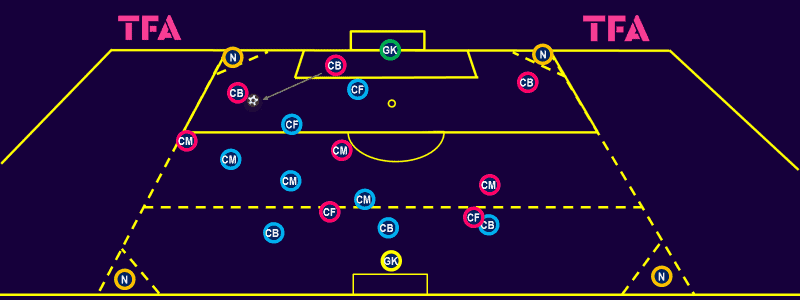
The aims of the central midfielders should be to screen the forwards and prevent the ball from being played into the final zone.
When exposed, the midfielders mustn’t overreact and jump at the ball, leaving space behind them.
To work on this, at the beginning of the exercise, teams must play through the zones before attacking the goal.
This small-sided game can then progress to the attacking team being able to play long, from their defensive zone to their front players (shown on the diagram).
This allows the coach to work on the reaction of the three centre-backs when the opposition misses their midfield.
This space down the sides of the centre-backs can be vulnerable when playing with three centre-backs.
This scenario could represent a long diagonal into a wide forward or advanced wing-back.
In these situations, the centre-backs should prioritise defending the goal area and drop back centrally.
They may press if they have an overload and the nearest defender is close enough to apply pressure to the forward’s first touch.
Otherwise, they defend the goal area and delay the play for a recovering midfielder to help.
The coach may add different restrictions to the wide forwards in the triangles.
Allowing them to leave the triangle and dribble, playing one touch and/or mandating the ball is crossed from these areas all give the defending team something different to think about.
11 vs 11 zone game
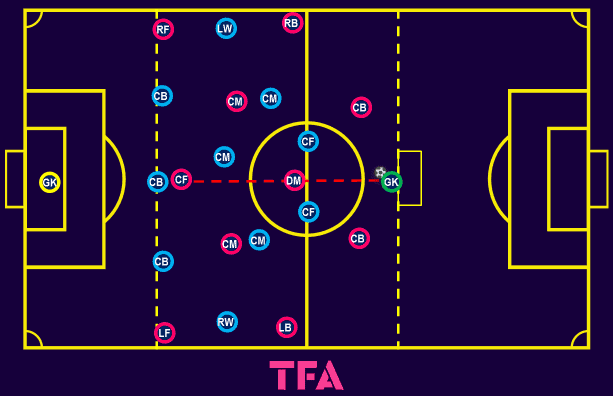
This 11 Vs 11 zone game allows teams to work on their shape in a mid or low block.
The centre-backs hold their line on the edge of their defensive third, with the forwards starting position on the halfway line.
As soon as the ball is in play, the forwards should press to keep the opposition down one side.
The attacking team, pink, must switch the ball over the red line, which splits the pitch in half before they can attack the goal.
This rule will highlight the effectiveness of the two forwards pressing and keeping the attacking team going down one side.
It also helps manufacture situations where the defending team’s wing-backs have to decide whether or not to jump to the ball on a switch of play.
To prepare the defending team for real opposition, the attacking team should be encouraged to take up positions that can cause team problems in a 3-5-2.
For example, the in-possession team’s full-backs can drop low to receive the ball in the build-up.
This gives the wing-back a decision on whether to press or have the forwards cover that player.
Conclusion
Defending in a 3-5-2 has the benefit of allowing teams to press with two central forwards.
This can help protect the central area and allow the forwards, working together, to trap the opposition down one side of the pitch.
Having three centre-backs provides an overload at the back.
This can allow the backline to track players dropping into midfield and not have to pass them on.
When defending the box, the back three quickly becomes a back five, comfortable covering the width of the box and allowing for pressure in the wide area.
Although there are downsides to the system, mainly long diagonals or teams doubling up in the wide area, especially from a switch of play, a 3-5-2 can offer a solid defensive solution.






Comments